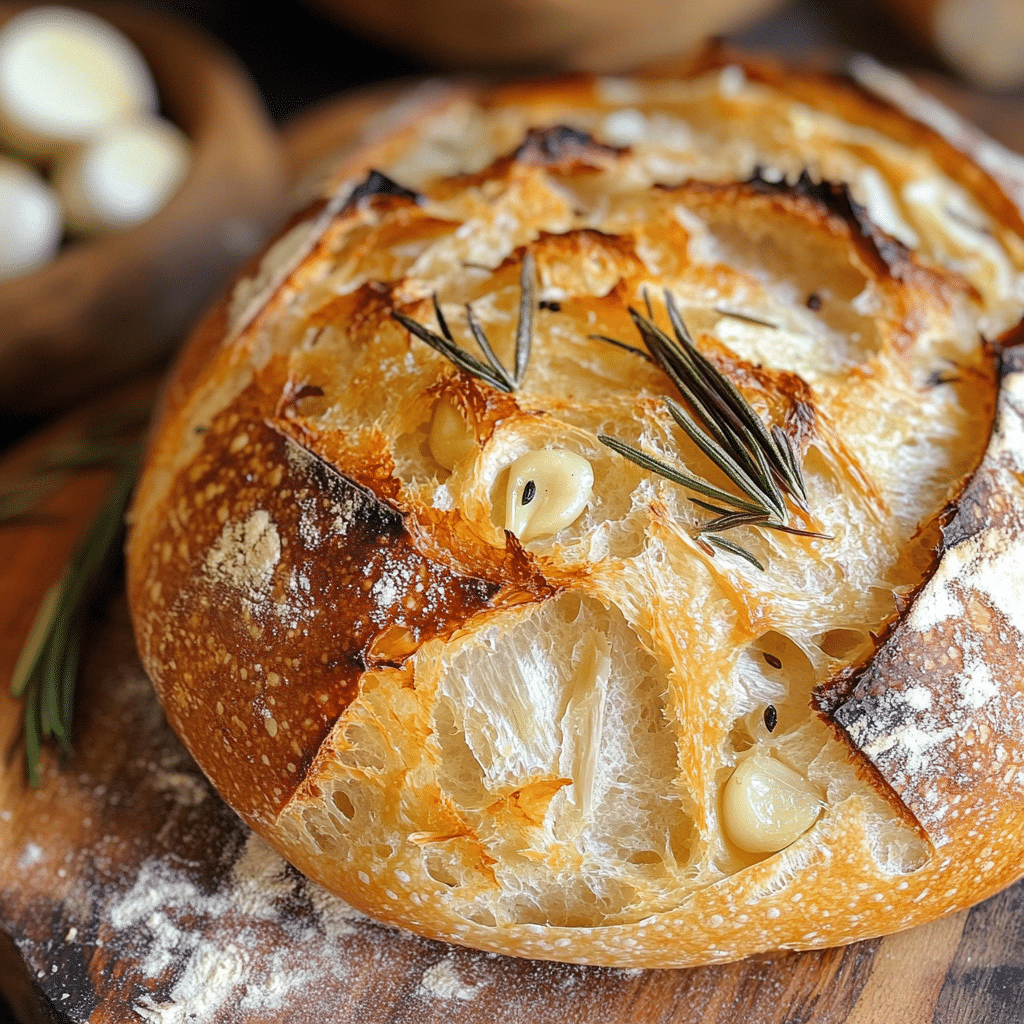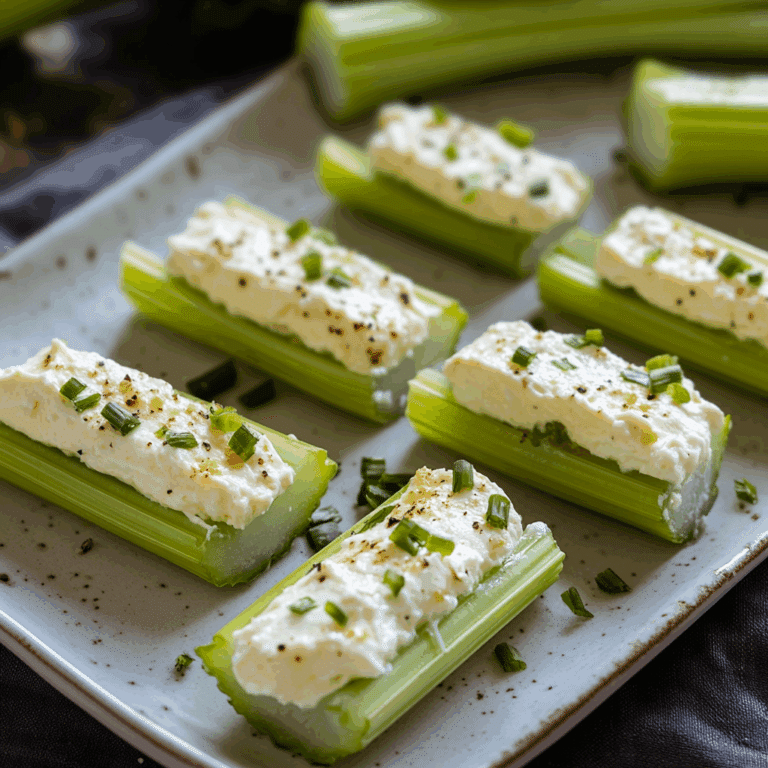How to Make Roasted Garlic and Rosemary Sourdough Bread

If you’re looking for a bread recipe that fills your kitchen with an irresistible aroma and delivers a deep, savory flavor, then this Roasted Garlic and Rosemary Sourdough Bread is your new best friend. This homemade loaf combines the tangy goodness of sourdough with the warm, mellow sweetness of roasted garlic and the fresh, piney notes of rosemary, creating a crusty, aromatic bite that’s perfect for any meal. Whether you’re a seasoned baker or just getting started, this recipe guides you through creating a beautiful, crusty loaf that’s truly made with love and exceptional flavor.
Why You’ll Love This Recipe
- Aromatic Flavor Blend: The combination of roasted garlic and fresh rosemary infuses the bread with a robust, savory taste that elevates any dish.
- Crusty Exterior, Tender Crumb: Thanks to the sourdough fermentation and baking technique, you get the perfect balance of a crunchy crust and soft inside.
- Natural Ingredients: Uses simple, wholesome ingredients with no artificial additives for a clean, homemade taste.
- Versatile Usage: Great for sandwiches, dipping in soups, or enjoying simply with butter.
- Impress Your Guests: Homemade sourdough always feels special and is sure to wow family and friends.
Ingredients You’ll Need
The ingredients for Roasted Garlic and Rosemary Sourdough Bread are straightforward yet essential to achieving that perfect flavor and texture. Each ingredient plays a vital role, whether it’s enhancing the bread’s aroma, structure, or crust color.
- Active Sourdough Starter: The natural yeast that brings life and a tangy depth to the bread’s flavor.
- Bread Flour: Provides the necessary gluten structure for a chewy, elastic crumb.
- Water: Hydrates the dough and activates the yeast without diluting the flavor.
- Sea Salt: Enhances all flavors while strengthening gluten bonds for better dough texture.
- Roasted Garlic: Adds a mellow, caramelized sweetness that’s less sharp than raw garlic.
- Fresh Rosemary: Offers piney, fragrant notes to brighten the otherwise earthy bread.
- Olive Oil (optional): Brushed on the crust for a glossy finish and subtle richness.
Variations for Roasted Garlic and Rosemary Sourdough Bread
This recipe is wonderfully flexible, making it easy to tailor depending on what ingredients you have on hand or dietary considerations. Feel free to experiment and make it your own!
- Sun-Dried Tomato Addition: Fold in chopped sun-dried tomatoes for a sweet and tangy twist alongside the garlic and rosemary.
- Gluten-Free Option: Substitute with a gluten-free sourdough starter and appropriate gluten-free flours, adjusting hydration as needed.
- Herb Mix Variation: Swap rosemary for thyme, sage, or a mix of herbs for different aromatic profiles.
- Cheese Infusion: Add shredded aged cheddar or parmesan to the dough for a savory cheesy boost.
- Spicy Kick: Incorporate crushed red pepper flakes for a subtle heat that complements the garlic.

How to Make Roasted Garlic and Rosemary Sourdough Bread
Step 1: Prepare the Roasted Garlic
Start by preheating your oven to 400°F (200°C). Take a whole garlic bulb, slice off the top to expose the cloves, drizzle with olive oil, wrap in foil, and roast for about 30-35 minutes until soft and fragrant. Let the roasted garlic cool, then squeeze out the cloves and mash them gently.
Step 2: Mix the Dough
In a large bowl, combine the active sourdough starter with water, mixing until dissolved. Add the bread flour, salt, freshly chopped rosemary, and the mashed roasted garlic. Stir the ingredients together to form a rough dough, then knead on a clean surface for 10-12 minutes until smooth and elastic.
Step 3: Bulk Fermentation
Place the dough in a lightly oiled bowl, cover it with a damp cloth or plastic wrap, and let it ferment at room temperature for about 4 to 6 hours until it doubles in size. During this time, stretch and fold the dough every hour to develop gluten and structure.
Step 4: Shape the Loaf
After the dough has fermented, gently turn it onto a floured surface, shape it into a tight boule or batard, and place it seam-side up in a well-floured banneton or bowl lined with a dish towel.
Step 5: Final Proof
Cover the shaped dough and let it proof for 2-3 hours at room temperature, or for a slower rise, refrigerate overnight. The extended cold proof enhances flavor complexity.
Step 6: Bake the Bread
Preheat your oven with a Dutch oven or heavy baking pot inside to 450°F (230°C). Carefully transfer the dough onto parchment paper, score the top with a sharp blade, and place it inside the preheated pot. Cover and bake for 20 minutes, then remove the lid and bake for another 20-25 minutes until golden brown and crusty.
Step 7: Cool Before Slicing
Let the Roasted Garlic and Rosemary Sourdough Bread cool completely on a wire rack. This step ensures the crumb sets properly, giving you those perfect slices every time.
Pro Tips for Making Roasted Garlic and Rosemary Sourdough Bread
- Use a Digital Scale: Accurate measurements improve consistency, especially with flour and water ratios.
- Hydration Matters: Slightly wetter dough favors a more open crumb, while drier dough yields a denser loaf.
- Don’t Skip the Stretch and Fold: This gentle technique strengthens gluten without over-kneading.
- Temperature Control: Keep fermentation at steady room temperature or adjust proofing times to suit your environment.
- Cold Fermentation: Refrigerating after shaping enhances flavor complexity and makes the dough easier to handle.
- Steam Your Oven: Adding steam in the first 15 minutes of baking helps develop a crisp, shiny crust.
How to Serve Roasted Garlic and Rosemary Sourdough Bread
Garnishes
Sprinkle a pinch of flaky sea salt or drizzle a little high-quality olive oil over warm slices to highlight the garlic and rosemary aroma instantly. Fresh rosemary sprigs on the side add a fragrant presentation touch.
Side Dishes
This bread perfectly pairs with hearty soups like tomato bisque or butternut squash, creamy cheeses such as brie or goat cheese, and charcuterie boards featuring cured meats and olives for a full-flavored experience.
Creative Ways to Present
Turn this bread into gourmet bruschetta by topping with diced tomatoes and basil, or slice thick for sandwiches packed with roasted veggies and melty cheese. Toast and spread it with herbed butter or hummus for quick snacks bursting with flavor.
Make Ahead and Storage
Storing Leftovers
Store leftover Roasted Garlic and Rosemary Sourdough Bread in a paper bag or a bread box at room temperature for up to 3 days to maintain the crust’s crispiness and crumb freshness.
Freezing
For longer storage, slice and freeze the bread in airtight bags. Thaw slices at room temperature or toast them directly from frozen to enjoy the same fresh taste anytime.
Reheating
To revive a day-old loaf, sprinkle it lightly with water and warm in a preheated 350°F (175°C) oven for 5-10 minutes. This method refreshes the crust and softens the crumb without drying it out.
FAQs
Can I use store-bought garlic instead of roasted garlic?
While raw garlic can be used, roasting garlic mellows its flavor and adds sweetness, which enhances the bread’s overall taste; roasting is worth the extra step.
Do I need a sourdough starter to make this bread?
Yes, an active sourdough starter is essential for authentic sourdough fermentation, providing natural leavening and flavor; however, you can experiment with commercial yeast if needed.
How long does the sourdough bread take to rise?
It typically takes between 4 to 6 hours for bulk fermentation at room temperature, with an additional 2 to 3 hours for the final proof, but timing can vary depending on ambient temperature and starter activity.
Can I substitute dried rosemary for fresh?
Fresh rosemary is preferred for its vibrant aromatic oils, but dried rosemary can be used in smaller amounts; however, it won’t provide quite the same freshness in flavor.
What’s the best way to score the bread before baking?
Use a sharp serrated knife or a razor blade to make quick, confident slashes on the dough’s surface; scoring controls how the bread expands and adds an artisan look.
Final Thoughts
There’s something truly magical about pulling a loaf of Roasted Garlic and Rosemary Sourdough Bread fresh from the oven—a loaf crusty on the outside, tender and fragrant on the inside. This recipe invites you to slow down, embrace the process, and reward yourself with a bread that’s as cozy and comforting as it is delicious. Give it a try, and soon your kitchen will be filled with the heartwarming scents of roasted garlic and rosemary that make everyday meals unforgettable.
Related Posts
- Why Jalapeño-Cheddar Pull-Apart Bread Is Irresistible
- Easy Chili Crisp Cottage Cheese Flatbreads Recipe
- Best Easy Bruschetta Recipes to Try Tonight
Roasted Garlic and Rosemary Sourdough Bread
This Roasted Garlic and Rosemary Sourdough Bread recipe combines the tangy depth of sourdough fermentation with the mellow sweetness of roasted garlic and the fragrant piney notes of fresh rosemary. The result is a crusty, aromatic loaf with a tender crumb, perfect for sandwiches, dipping, or enjoying with butter. Ideal for both beginner and seasoned bakers, this homemade bread fills your kitchen with irresistible aromas and delivers rich, savory flavor.
- Prep Time: 15 mins
- Cook Time: 45-50 mins
- Total Time: 6-9 hours (including fermentation and proofing time)
- Yield: 1 loaf (about 1.5 lbs) 1x
- Category: Appetizers
- Method: Baking
- Cuisine: American
- Diet: Contains Gluten
Ingredients
Main Ingredients
- 1 cup active sourdough starter
- 4 cups bread flour
- 1 ½ cups water
- 2 teaspoons sea salt
- 2 tablespoons roasted garlic (mashed cloves)
- 2 tablespoons fresh rosemary (chopped)
Optional
- Olive oil (for brushing crust)
Instructions
- Prepare the Roasted Garlic: Preheat oven to 400°F (200°C). Slice the top off a whole garlic bulb to expose the cloves. Drizzle with olive oil, wrap in foil, and roast for 30-35 minutes until soft and fragrant. Let cool, then squeeze out and mash the cloves gently.
- Mix the Dough: In a large bowl, mix the active sourdough starter with water until dissolved. Add bread flour, sea salt, chopped rosemary, and mashed roasted garlic. Stir to form a rough dough, then knead on a floured surface for 10-12 minutes until smooth and elastic.
- Bulk Fermentation: Place dough in a lightly oiled bowl, cover with a damp cloth or plastic wrap, and ferment at room temperature for 4 to 6 hours until doubled in size, performing stretch and folds every hour to strengthen gluten.
- Shape the Loaf: Transfer dough gently onto a floured surface. Shape into a tight boule or batard and place seam-side up in a well-floured banneton or bowl lined with a towel.
- Final Proof: Cover the shaped dough and proof at room temperature for 2-3 hours or refrigerate overnight for a slower rise and enhanced flavor.
- Bake the Bread: Preheat oven to 450°F (230°C) with a Dutch oven or heavy pot inside. Carefully transfer dough on parchment paper into the pot, score the top with a sharp blade, cover, and bake for 20 minutes. Remove lid and bake for another 20-25 minutes until golden and crusty.
- Cool Before Slicing: Let bread cool completely on a wire rack to set the crumb before slicing for perfect texture.
Notes
- Use a digital scale for precise measurements of flour and water.
- Adjust hydration for desired crumb openness; wetter dough yields more open crumb.
- Perform stretch and folds during fermentation instead of over-kneading.
- Maintain steady room temperature during fermentation or adjust times accordingly.
- Cold proofing overnight enhances flavor complexity and dough handling.
- Introduce steam in the oven during initial baking for a crisp, shiny crust.
Nutrition
- Serving Size: 1 slice (about 70g)
- Calories: 180
- Sugar: 0.3g
- Sodium: 350mg
- Fat: 1.5g
- Saturated Fat: 0.2g
- Unsaturated Fat: 1.2g
- Trans Fat: 0g
- Carbohydrates: 38g
- Fiber: 2g
- Protein: 6g
- Cholesterol: 0mg
Keywords: sourdough bread, roasted garlic bread, rosemary bread, homemade bread, artisan bread







